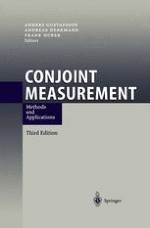2003 | OriginalPaper | Chapter
A Comparison of Conjoint Measurement with Self-Explicated Approaches
Authors : Henrik Sattler, Susanne Hensel-Börner
Published in: Conjoint Measurement
Publisher: Springer Berlin Heidelberg
Included in: Professional Book Archive
Activate our intelligent search to find suitable subject content or patents.
Select sections of text to find matching patents with Artificial Intelligence. powered by
Select sections of text to find additional relevant content using AI-assisted search. powered by
Over the past two decades conjoint measurement has been a popular method for measuring customers’ preference structures. Wittink and Cattin (1989) estimate that about 400 commercial applications were carried out per year during the early 1980s. In the 1990s this number probably exceeds 1000. The popularity of conjoint measurement appears to derive, at least in part, from its presumed superiority in validity over simpler, less expensive techniques such as self-explication approaches (Leigh, MacKay and Summers 1984). However, when considered in empirical studies, this superiority frequently has not been found (e.g. Green and Srinivasan 1990; Srinivasan and Park 1997). This issue is of major practical relevance. If, at least in certain situations, conjoint measurement is not clearly superior in validity to self-explicated approaches, it becomes highly questionable whether future applications for measuring customers’ preferences should be done by conjoint measurement, as self-explicated approaches are clear advantageous in terms of time and money effort.
